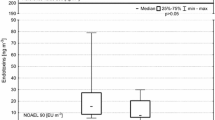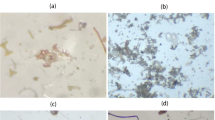Abstract
In this study, the airborne and dust-borne concentrations of endotoxin, (1,3)-β-d-glucan and five house dust allergens were measured in office, home, and outdoor environments both in New Haven, United States and Nanjing, China. Air samples were collected using a BioSampler at a flow rate of 12.5 l/min for 30 min. Dust samples were simultaneously collected using a surface sampler. Dust samples went through extraction and dilution before analysis, while air samples were analyzed directly. Limulus Amoebocyte Lysate (LAL) Pyrochrome and Glucatell assays were used to quantify endotoxin and (1,3)-β-d-glucan concentration levels, respectively. Enzyme-linked sorbent assay was used to measure the dust mites, cat, dog, and cockroach allergens. The experimental results indicated that endotoxin, (1,3)-β-d-glucan and allergen concentrations vary greatly both with samples and environments. In all tested environments, endotoxin concentration ranged from 0.8 to 83.7 ng/m3 for air, and 7.8 to 14.3 ng/mg for dust. (1,3)-β-d-glucan concentration ranged from 0.1 to 9.8 ng/m3 for air, and 6.6 to 110 ng/mg for dust. Cockroach allergens were detected only in New Haven office and outdoor environments, and other allergens ranged from 0.1 to 90 ng/mg for dust samples, and from 1.5 to 1,282 ng/m3 for air samples. In general, similar profiles of allergens and toxins were observed in New Haven and Nanjing environments. Linear regression analysis showed that there were better endotoxin and (1,3)-β-d-glucan linear correlations (R 2 = 0.78, 0.87, respectively) between the dust and air samples compared to those of the allergens Der f 1 and Der p 1 (R 2 = 0.5, 0.7, respectively). This research contributes to the development of robust biological exposure assessment and the elaboration of airborne and dust-borne bio-mass in the living environments.






Similar content being viewed by others
References
Chew, G. L., Rogers, C., Burge, H. A., Muilenberg, M. L., & Gold, D. R. (2003). Dustborne and airborne fungal propagules represent a different spectrum of fungi with differing relations to home characteristics. Allergy, 58, 13–20. doi:10.1034/j.1398-9995.2003.00013.x.
Custis, N. J., Woodfolk, J. A., Vaughan, J. W., & Platts-Mills, T. A. E. (2003). Quantitative measurement of airborne allergens from dust mites, dogs, and cats using an ion-charging device. Clinical and Experimental Allergy, 33, 986–991. doi:10.1046/j.1365-2222.2003.01706.x.
Custovic, A., Woodcock, H., Craven, M., Hassall, R., Hadley, E., Simpson, A., et al. (1999). Dust mite allergens are carried on not only large particles. Pediatric Allergy & Immunology, 10, 258–260. doi:10.1034/j.1399-3038.1999.00050.x.
Czop, J. K., & Kay, J. (1991). Isolation and characterization of beta-glucan receptors on human mononuclear phagocytes. The Journal of Experimental Medicine, 73, 1511–1520. doi:10.1084/jem.173.6.1511.
Dales, R., Miller, D., Ruest, K., Guay, M., & Judek, S. (2006). Airborne endotoxin is associated with respiratory illness in the first 2 years of life. Environmental Health Perspectives, 114, 610–614.
Douwes, J., Thorne, P., Pearce, N., & Heederik, D. (2003). Bioaerosol health effects and exposure assessment: Progress and prospects. Annals of Hygiene, 47, 187–200. doi:10.1093/annhyg/meg032.
Douwes, J., Versloot, P., Hollander, A., Heederik, D., & Doekes, G. (1995). Influence of various dust sampling and extraction methods on the measurement of airborne endotoxin. Applied and Environmental Microbiology, 61, 1763–1769.
Duchaine, C., Thorne, P. S., Mériaux, A., Grimard, Y., Whitten, P., & Cormier, Y. (2001). Comparison of endotoxin exposure assessment by bioaerosol impinger and filter-sampling methods. Applied and Environmental Microbiology, 67, 2775–2780. doi:10.1128/AEM.67.6.2775-2780.2001.
Foto, M., Plett, J., Berghout, J., & Miller, J. (2004). Modification of the limulus amebocyte lysate assay for the analysis of glucan in indoor environments. Analytical and Bioanalytical Chemistry, 379, 156–162. doi:10.1007/s00216-004-2583-4.
Kreiss, K. (1989). The epidemiology of building-related complaints and illness. Occupational Medicine (Philadelphia, PA), 4, 575–592.
Leaderer, B. P., Belanger, K., Triche, E., Holford, T., Gold, D. R., Kim, Y., et al. (2002). Dust mite, cockroach, cat, and dog allergen concentrations in homes of asthmatic children in the northeastern United States: Impact of socioeconomic factors and population density. Environmental Health Perspectives, 110, 419–425.
Lee, S. Y., Choi, J., Han, K., & Song, J. Y. (1999). Removal of endotoxin during purification of poly(3-hydroxybutyrate) from gram-negative bacteria. Applied and Environmental Microbiology, 65, 2762–2764.
Lester, E. D., & Ponce, A. (2002). An anthrax smoke detector: online detection of aerosolized bacterial spores. IEEE Engineering in Medicine and Biology Magazine, 21, 38–42.
Lin, X., Reponen, T. A., Willeke, K., Grinshpun, S. A., Foarde, K. K., & Ensor, D. S. (1999). Long-term sampling of airborne bacteria and fungi into a non-evaporating liquid. Atmospheric Environment, 33, 4291–4298. doi:10.1016/S1352-2310(99)00169-7.
Luczynska, Sterne, Bond, Azima, & Burney. (1998). Indoor factors associated with concentrations of house dust mite allergen, der p 1, in a random sample of houses in Norwich, UK. Clinical and Experimental Allergy, 28, 1201–1209. doi:10.1046/j.1365-2222.1998.00410.x.
Matsui, E. C., Wood, R. A., Rand, C., Kanchanaraksa, S., Swartz, L., Curtin-Brosnan, J., et al. (2003). Cockroach allergen exposure and sensitization in suburban middle-class children with asthma. The Journal of Allergy and Clinical Immunology, 112, 87–92. doi:10.1067/mai.2003.1588.
Proud, D., Bailey, G. S., Naclerio, R. M., Reynolds, C. J., Cruz, A. A., Eggleston, P. A., et al. (1992). Tryptase and histamine as markers to evaluate mast cell activation during the responses to nasal challenge with allergen, cold, dry air, and hyperosmolar solutions. The Journal of Allergy and Clinical Immunology, 89, 1098–1110. doi:10.1016/0091-6749(92)90293-B.
Rylander, R. (1999). Indoor air-related effects and airborne (1-3)-beta-d-glucan. Environmental Health Perspectives, 107, 501–503. doi:10.2307/3434634.
Rylander, R. (2005). (1→3)-β-d-glucan in the environment: A risk assessment. In S.-H. Young & V. Castranova (Eds.), Toxicology of (1→3)-β- d -glucans (pp. 53–64). Taylor & Francis: Boca Raton, FL.
Rylander, R., Thorn, J., & Attefors, R. (1999). Airways inflammation among workers in a paper industry. European Respiratory Journal, 13, 1151–1157. doi:10.1034/j.1399-3003.1999.13e35.x.
Rylander, R., Persson, K., Goto, H., Yuasa, K., Shigenori, T., & Aalberse, R. C. (1992). Airborne 1, 3- Beta-d-Glucan may be related to symptoms in sick buildings. Indoor and Built Environment, 1, 263–267. doi:10.1177/1420326X9200100502.
Sohy, C., Lieutier-Colas, F., Casset, A., Meyer, P., Pauli, G., Pons, F., et al. (2005). Dust and airborne endotoxin exposure in dwellings in the Strasbourg Metropolitan Area (France). Allergy, 60, 541–542. doi:10.1111/j.1398-9995.2005.00742.x.
Solomon, G. M., Hjelmroos-Koski, M., Rotkin-Ellman, M., & Hammond, S. K. (2006). Airborne mold and endotoxin concentrations in New Orleans, Louisiana, after flooding, October through November 2005. Environmental Health Perspectives, 114, 1410–1420.
Thorn, J., & Rylander, R. (1998). Airways inflammation and glucan in a rowhouse area. American Journal of Respiratory and Critical Care Medicine, 157, 1798–1803.
Thorne, P. S. (2000). Inhalation toxicology models of endotoxin and bioaerosol-induced inflammation. Toxicology, 152, 13–23. doi:10.1016/S0300-483X(00)00287-0.
Acknowledgments
This study was supported by the Peking University “100 Scholar Program” Fund and the National Science Foundation of China, Grant 20877004.
Author information
Authors and Affiliations
Corresponding author
Rights and permissions
About this article
Cite this article
Yao, M., Wu, Y., Zhen, S. et al. A comparison of airborne and dust-borne allergens and toxins collected from home, office and outdoor environments both in New Haven, United States and Nanjing, China. Aerobiologia 25, 183–192 (2009). https://doi.org/10.1007/s10453-009-9123-9
Received:
Accepted:
Published:
Issue Date:
DOI: https://doi.org/10.1007/s10453-009-9123-9




